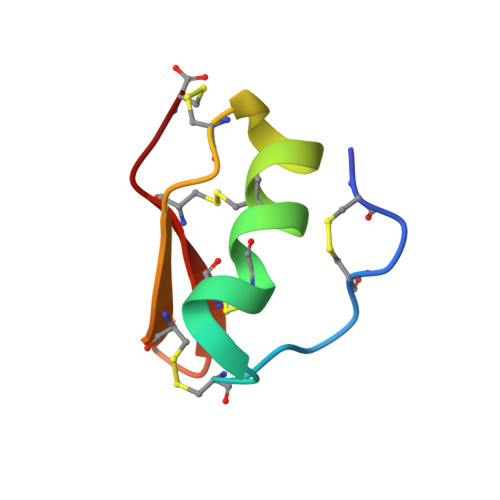Increasing the molecular contacts between maurotoxin and Kv1.2 channel augments ligand affinity.
M'Barek, S., Chagot, B., Andreotti, N., Visan, V., Mansuelle, P., Grissmer, S., Marrakchi, M., El Ayeb, M., Sampieri, F., Darbon, H., Fajloun, Z., De Waard, M., Sabatier, J.M.(2005) Proteins 60: 401-411
- PubMed: 15971207
- DOI: https://doi.org/10.1002/prot.20509
- Primary Citation of Related Structures:
1WT7 - PubMed Abstract:
Scorpion toxins interact with their target ion channels through multiple molecular contacts. Because a "gain of function" approach has never been described to evaluate the importance of the molecular contacts in defining toxin affinity, we experimentally examined whether increasing the molecular contacts between a toxin and an ion channel directly impacts toxin affinity. For this purpose, we focused on two scorpion peptides, the well-characterized maurotoxin with its variant Pi1-like disulfide bridging (MTX(Pi1)), used as a molecular template, and butantoxin (BuTX), used as an N-terminal domain provider. BuTX is found to be 60-fold less potent than MTX(Pi1) in blocking Kv1.2 (IC(50) values of 165 nM for BuTX versus 2.8 nM for MTX(Pi1)). Removal of its N-terminal domain (nine residues) further decreases BuTX affinity for Kv1.2 by 5.6-fold, which is in agreement with docking simulation data showing the importance of this domain in BuTX-Kv1.2 interaction. Transfer of the BuTX N-terminal domain to MTX(Pi1) results in a chimera with five disulfide bridges (BuTX-MTX(Pi1)) that exhibits 22-fold greater affinity for Kv1.2 than MTX(Pi1) itself, in spite of the lower affinity of BuTX as compared to MTX(Pi1). Docking experiments performed with the 3-D structure of BuTX-MTX(Pi1) in solution, as solved by (1)H-NMR, reveal that the N-terminal domain of BuTX participates in the increased affinity for Kv1.2 through additional molecular contacts. Altogether, the data indicate that acting on molecular contacts between a toxin and a channel is an efficient strategy to modulate toxin affinity.
Organizational Affiliation:
Laboratoire d'Ingénierie des Protéines, CNRS FRE 2738, IFR Jean Roche, Faculté de Médecine Nord, Marseille, France.














